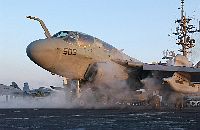
The Source for Navy News
VAQ-136 Gauntlets Put Deployment in the History Books
Story Number: NNS030602-03
Release Date: 6/2/2003 9:33:00 AM
By Lt. j.g. Tom Clarity, Electronic Attack Squadron 136 Public Affairs
NAVAL AIR FACILITY ATSUGI, Japan (NNS) -- The Gauntlets of Electronic Attack Squadron (VAQ) 136 returned home May 6, after a deployment that involved support to Operations Southern Watch and Iraqi Freedom.
After a four-year absence from the Arabian Gulf, VAQ-136, embarked aboard USS Kitty Hawk (CV 63), returned with style.
Gauntlets flew more than 500 hours and 105 combat missions in 26 days, six High Speed Anti-Radiation Missiles (HARMs) were launched and countless “trons” provided valuable protection for coalition aircraft in the skies above Iraq. Trons, or electrons, refer to the radiated energy from the Gauntlets' EA-6B Prowler’s jamming pods. They provide protection by “jamming” or blocking, the enemy radar from getting an accurate radar picture of Navy aircraft, which inhibits the ability to shoot down aircraft with surface to air missiles.
The Gauntlets also logged 1,000 hours on their modified Night Vision Devices (NVDs), which filter ambient light to increase a pilot’s visibility while flying at night. Gauntlet parachute riggers and aviation electricians performed this modification to allow aircrew to visually acquire other aircraft, and avoid Iraqi surface to air missiles, rockets and anti-aircraft artillery.
VAQ-136 aircrew flew missions in excess of six hours, often within a single flight, flexing from Suppression of Enemy Air Defenses (SEAD) to Electronic Attack Close Air Support and coverage for Special Operations Forces.
Gauntlets flew extended missions that directly supported the insertion of Special Operations Forces on the Al Faw peninsula, which was important in achieving control of the Southern Iraqi oil fields. They were airborne during the first strikes on Baghdad, and along with a section of F-14 Tomcats, penetrated further Northwest than any other aircraft on “A-day,” the first official day of the air war. Almost three weeks later, they were again airborne when Baghdad fell to coalition ground forces.
These feats were accomplished due to the Gauntlet maintainers, who worked around the clock to ensure the mission readiness of their Prowler aircraft. As an example of their effectiveness, one aircraft was over Iraq shooting HARMs only one day after a discrepancy-free Functional Check Flight (FCF). FCFs are done after an aircraft has received extensive maintenance that requires it be flown through various flight profiles before it can be certified combat ready.
On several occasions, four of the five Prowlers were “over the beach” at the same time with fully operable weapons and self-protection systems, due to the hard work and dedication of every Gauntlet maintainer.
The U.S. Navy’s 2002 Prowler Maintenance Squadron of the Year proved its mettle once again, as Gauntlet aircraft demonstrated both their dependability and formidability in the skies above Iraq.
“Teamwork made everything happen,” said Chief Aviation Electrician’s Mate Troy Tomey.
Other Gauntlet cruise milestones included nine Gauntlet aircrew becoming Kitty Hawk centurions by recording 100 arrested landings.
Before returning to Japan, Gauntlets received a special visit from Rear Adm. Matthew Moffit, Commander, Carrier Air Group 5.
Moffit said, “Everybody was in awe of what you did out here. You freed 22 million people from tyranny.”
VAQ-136 Commanding Officer, Cmdr. Stephen McInerney, praised the Gauntlets for all their hard work.
“It’s been an honor to serve as your commanding officer... You have done something that has made you a different person than you were two months ago. You have done something historic.”
For related news, visit the Naval Air Facility Atsugi, Japan Navy NewsStand page at www.news.navy.mil/local/nafatsugi.
E-mail this story to a friend | Send a comment about this story
Gauntlets Put Hussein Regime Assets in 'HARM’s Way' - 5/1/2003Gauntlets Reach Milestone - 4/18/2003
|
All Any Exact |
|
